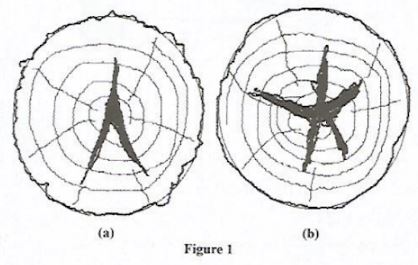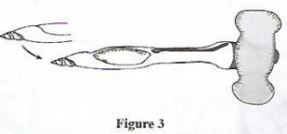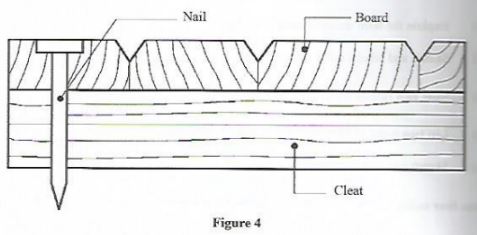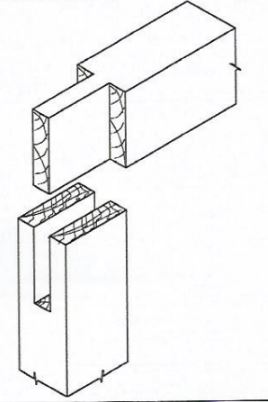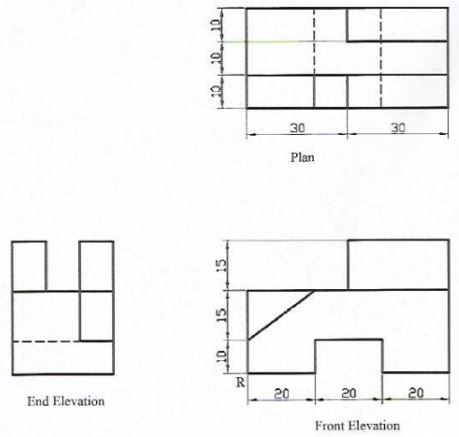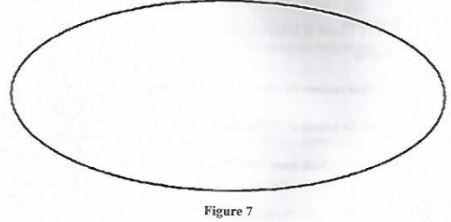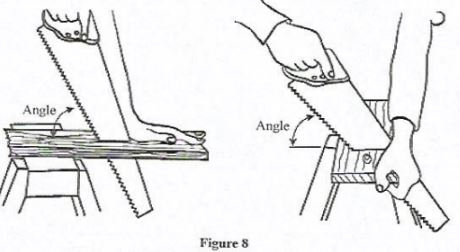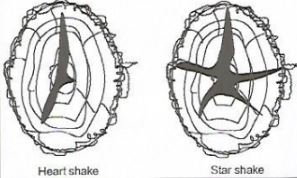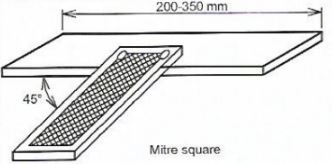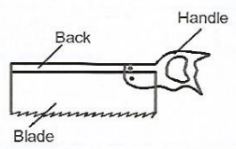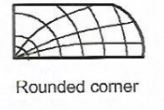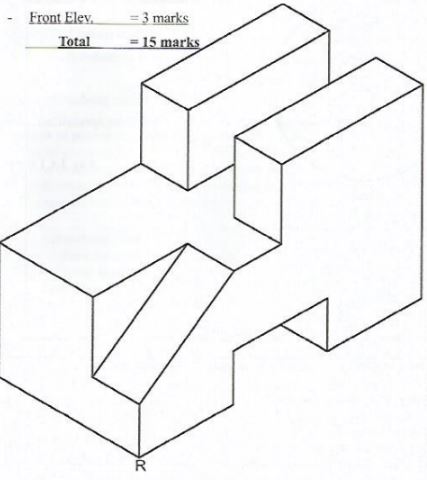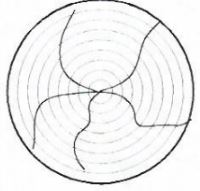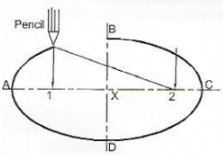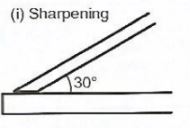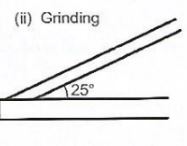Woodwork Paper 1 (444/1)
SECTION A (40 marks)
Answer all the questions in this section in the spaces provided.
-
- List four safety requirements in relation to floor layout in a wood workshop(2 marks)
- State four performance requirements of a door(4 marks)
-
- Name the type of timber defects shown in Figure 1 (a) and (b).(2 marks)
- Explain the term decay as used in timber. (2 marks)
- Name the type of timber defects shown in Figure 1 (a) and (b).(2 marks)
-
- Sketch and label a mitre square. (3 marks)
- State two factors which determine the position of a pit latrine on a site. (2 marks)
-
- List two types of hand saws(1 mark)
- Sketch and label a tenon saw.(4 marks)
- State four safety precautions to observe when planing wood.(4 marks)
-
- Figure 2 shows a bradawl.
State two uses of the bradawl.(1 mark) - Figure 3 shows a gimlet.
State its advantages over a brace.
- Figure 2 shows a bradawl.
-
- State two uses of each of the following planes:
- Plough plane.
- Rebate plane.
- Figure 4 shows two pieces of timber joined together with a nail
State two methods that may be used to avoid penetration of the nails past the cleat
- State two uses of each of the following planes:
- Give two examples in cach of the following types of glue:
- Protein adhesives(2 marks)
- Synthetic resin adhesives(2 marks)
- Use cross-sectional sketches to distinguish between the following edge finishes:
- Rounded corner.(1 mark)
- Rounded nosing(1 mark)
- Figure 5 shows an Isometric view of a briddle joint
Sketch an exploded view of the joint. (4 marks)
SECTION B (60 marks)
Answer question 11 on the A3 paper and any other three questions from this section in the spaces
provided. Candidates are achised not to spend more than 25 minutes on question 11.
- Figure 6 shows three views of a shaped block drawn in third angle projection,
To a scale of 2:1, draw the block in isometric projection taking R as the lowest point. (15 marks) -
- List four types of widening joints.(2 marks)
- Outline the procedure of making a glued rebated butt joint(8 marks)
- Sketch to show the plain method of timber conversion and state three advantages of this method(5 marks)
-
- Outline the procedure of preparing a log in readiness for cutting veneers. (7 marks)
- Figure 7 shows an elliptical table top
Using the tramnel method, outline the procedure of marking out the top on a rectangular board. (5 marks) - State three methods of protecting the sides of a trench excavation from collapsing. (3 marks)
-
- Name three types of bench planes, and give one use of each. (6 marks)
- Figure 8 shows two methods of sawing timber.
Name each method and describe the procedure stating the suitable angle of cut,(9 marks)
-
- With the aid of sketches explain the following methods of reconditioning plane blades. (5 marks)
- Sharpening
- Grinding
-
- State four reasons for staining wood surfaces. (4 marks)
- Outline the procedure of staining a piece of timber. (4 marks)
- State four ways in which waste wood can be utilised(2 marks)
- With the aid of sketches explain the following methods of reconditioning plane blades. (5 marks)
MARKING SCHEME
-
- Workshop safety:
- Machine layout.
- Layout of workbenches.
- Escape route.
- Tidiness.
- Non-slippery floor.
- Position of doors.
Any 4 x ½ = (2 marks)
- Performance requirements of a door:
- Weather exclusion.
- Security Fire.
- Thermal and sound insulation.
- Privacy
- Durability.
- Method of operation.
Any 4x1 = (4 marks)
- Workshop safety:
-
-
- Decay
This is the decomposition of the wood due to the action of wood destroying fungi.
- Decay
-
-
-
-
- Distance from the buildings
- Topology of the site
- Nature of the soil
Any 2x1=2
-
-
- Handsaws
- Rip saw
- Crosscut saw
- Panel saw
Any 2 x ½= (1 mark)
-
- Handsaws
-
- Ensure the piece of wood to be planned is firmly held in the vice.
- Use the right plane for the correct job.
- Before starting to plane check to ensure that the plane is in the right condition.
- As much as possible avoid planning against the grains.
4 x1 = (4 marks)
-
- Uses of a bradawl
- Making small holes for nails
- Making small holes for screws.
- Threading holes for screws.
Any 2 x ½= (1 mark)
- Advantages of a gimlet
- Can be used where a brace cannot be used.
- Used particularly in narrow or tight places.
Any 2x1= (1 mark)
- Uses of a bradawl
-
- Uses of:
Rebate plane Plough plane -Cutting rebates.
-Clearing Tenon shoulders.
-Clearing the chamfer.-Cutting grooves.
-Making rebates.
-Levelling bottom of grooves. - To avoid penetration of nails beyond the cleat:
- Use diagonal nailing.
- Select correct size of nail.
2x1=(2 marks)
- Uses of:
-
- Protein glues
- Animal glue
- Casein glue
- Soya bean
- Blood albumin
Any 2 x1 = (2 marks)
- Synthetic resin glues
- Urea
- Melamine
- Resorcinol P
- henol-formaldehyde
(2 marks)
- Protein glues
-
-
- BRIDLE JOINT (EXPLODED VIEW)
Proportionality = 1
Shoulders = 2
Tenon = 1
= 4 marks (4 marks) - Correct position of R=1 mark
Correct isometric = 2 marks
Line work = 1 mark
Correct views on
Plan = 3 marks
End Elev. = 3 marks
Front Elev. = 3 marks
Total = 15 marks -
- Joints uses for widening boards:
- Rubbed and glued.
- Glued plus corrugated fasteners.
- Doweled.
- Slot screwed.
- Tongued and grooved,
- Rebated.
Any 4 x ½ = (2 marks)
- Procedure of making a box with rebated butt joint.
- Prepare the pieces to the required dimensions.
- Using a marking gauge, mark the rebates.
- Set the rebate plane to the required depth and width.
- Clamp the pieces together.
- Plane the work pieces to required size.
- Assemble the joint dry.
- Correct any irregularities in the joint.
- Apply glue and clamp the pieces.
8x1 = 8 marks
-
Advantages- It is the simplest method.
- It is the most economical method.
- Suitable for mass production.
- It does not require specialized skill.
Any 3 x1=3
Sketching - 2
Advantages - 3
(5 marks)
- Joints uses for widening boards:
-
- Procedure of preparing a log in readiness for cutting veneers.
- Select suitable tree.
- Cut it to the required length.
- Prepare the log.
- Debark the log.
- Steam the log to soften it.
- Fix the log onto the rotary or lathe.
- Shape the log truly round in readiness for peeling into veneers.
7x1=(7 marks)
- Marking out Table top using the trammel method.
- Lay out the length. Call it AC.
- Set compass at ½ distance of Pencil AC
- Use B as a centre point to draw arcs intersecting AC at points 1 and 2.
- Insert a pin at points 1, 2 and B Fasten a string tightly around the three pins.
- Remove the pin at point B.
- Replace it with a sharp pencil.
- Keep the string tight as you.
- Draw the line forming the ellipse. (5 marks)
- Methods of protecting sides of trenches from collapsing
- Use of excavated spoil to forn barriers on the sides.
- Close boarding/sheeting projecting above ground level.
- Continuous rail fixed on top of projecting poling boards.
- Continuous tubular rail on tripods.
Any 3 x 1 = 3 marks
- Procedure of preparing a log in readiness for cutting veneers.
-
-
- Smoothing plane
- Best for short lengths of wood and for final cleaning-up of a wood surface.
- Jack plane
- Used for general purpose planning.
- Try plane
- Designed to remove bumps and hollows from long pieces of wood.
Naming types = 3 x 1 = 3
Explanation. = 3 x1=3
- Designed to remove bumps and hollows from long pieces of wood.
- Smoothing plane
-
- Ripping
- Use a rip-saw to cut along the grain. Hold the wood firmly on a bench or trestle. Use the saw at a low angle to start the cut and continue at 60°, using the full blade length.
- Cross-cutting
- Use a cross-cut saw to cut across the grain. The saw is held at 45° and you firmly support the waste, or overhanging end. When finishing the cut, use gentle strokes to prevent tearing.
Angle 2 x ½= 1
Name 2 x 1=2
Expl. 2 x 3 = 6
= 9 marks
- Use a cross-cut saw to cut across the grain. The saw is held at 45° and you firmly support the waste, or overhanging end. When finishing the cut, use gentle strokes to prevent tearing.
- Ripping
-
-
- Methods of re-conditioning plane blades.
- Sharpening
- The blade is sharpened at an angle of 30°. If it is too steep, penetration is difficult.
- Grinding
- This is usually put by the manufacturer and should be 25o.
- This angle should be maintained when reconditioning planes,
SKETCH=2
Expl. = 3
= 5
(5 marks)
- Sharpening
-
- Reasons for staining
- Create colour.
- Matching the piece to another/harmony.
- Enhancing appearance.
- Repair displeasing colours.
- Greater durability.
Any 4x1=(4 marks)
- Procedure of staining
- Apply the stain preferably in one go over the entire surface using a brush, sponge or a clean piece of cloth. Any excess stain is rubbed out using a clean tint-free cloth.
- The end grains should be made damp with water before applying stain to reduce absorption. Allow stain to dry completely for at least 2 hours in a well ventilated room.
(4 marks)
- Reasons for staining
- Utilization of waste woods.
- Using as firewood/fuel.
- Crushed/ground and sold to farmers for breeding kitchen.
- For making manufactured boards.
- Can be used as manure by farmers
Accept any other correct answer.
4 x ½ = (2 marks)
- Methods of re-conditioning plane blades.
Download KCSE 2019 Woodwork Paper 1 Questions with Marking Scheme.
Tap Here to Download for 50/-
Get on WhatsApp for 50/-
Why download?
- ✔ To read offline at any time.
- ✔ To Print at your convenience
- ✔ Share Easily with Friends / Students

